Copper in construction | Paving the way to a sustainable future
As the first metal manipulated and used by humans, copper has played a pivotal role in our development, driving innovation across a range of industries.
One of the areas where copper was first used – and continues to be used – is construction. The ancient Egyptians were some of the first to incorporate copper into their construction projects, and to this day the red metal remains one of the most sought-after building materials.
In fact, the demand for copper in construction is arguably greater than ever before, with the urgency of the climate crisis calling for sustainable building materials like copper that meet the needs of the circular economy.
Why is copper used in construction?
Copper has a unique set of properties that make it especially suited to construction. Not only is it non-corrosive, malleable and aesthetically pleasing, but its high melting point and natural antimicrobial resistance also make it a great choice for improving building safety.
Copper is corrosion resistant
One of the most important factors when specifying building materials is longevity. As a non-ferrous metal, copper does not rust, and it also has great corrosion resistance thanks to the naturally protective film that forms on its surface.
This protective film, or patina, is the result of natural oxidation as copper reacts with oxygen in the air to form copper oxide. The patina preserves the underlying copper from further corrosion, while also colouring the surface with a distinctive blue-green hue.
These qualities mean that copper products like pipes, cladding panels and roofing sheets can last many decades with minimal maintenance or repairs, helping to maximise the service life of a building.
Copper is fire resistant
Another major strength of copper in construction is the metal’s high melting point of around 1,085°C, which comfortably exceeds the temperature of the average building fire.
In the event of a fire, copper components can be trusted not to ignite, helping to slow the spread of the blaze. The same cannot be said for many plastics, which are being used increasingly in construction and pose a serious risk to fire safety.
On top of this, copper has a low thermal expansion coefficient, which means that it expands only marginally when exposed to heat. This is important as significant thermal expansion can lead to serious damage and even structural failure of a building.
Copper is malleable
Along with being an incredibly durable material, copper is also malleable and ductile, meaning it can be bent and stretched into the various shapes required for different construction materials and also pulled into wires.
Copper owes its malleability to the arrangement of its atoms. When copper is worked into shape, the atoms slide over each other while still being held together by the delocalised electrons, preventing the copper from breaking.
This is why copper is often specified in plumbing installations where pipes need to travel through walls and fit into tight, intricate spaces. The red metal’s malleable qualities also make it suitable for small mechanical components and elaborate ornamental products.


Copper is naturally antimicrobial
Copper’s antimicrobial properties may only recently have been confirmed by modern science, but they have been in use for thousands of years, long before a full understanding of bacteria and other microbes was fully developed.
There are records of the red metal being used to sterilise wounds and water in Ancient Egypt, while doctors in the Ancient Greece and the Roman Empire prescribed copper to treat a number of ailments, including headaches, eye problems and leg ulcers.
Today, we know that copper alloys are effective in killing harmful bacteria like MRSA and E. coli, as well as many viruses like COVID-19. This is because contact with the copper surface weakens the microbe’s cell wall, leaving it susceptible to damage from copper ions.
Copper is aesthetically pleasing
Another reason why copper is so popular among architects and designers is its unique appearance. The metal can be found across the built environment in a range of shades, from the red-orange tint of its pure form to a darker, iridescent brown, and finally its distinctive green patina.
For many people, copper evokes a sense of luxury and prestige, which is why it is often used to make sculptures, as well as design elements like doors, gates, cladding and roofing for important public buildings.
In the home, the red metal is incorporated into everything from countertops, lighting and staircases to sinks, door handles and pipework.
Copper is infinitely recyclable
Arguably the biggest strength of copper is its ability to be recycled repeatedly without any loss of quality, making it one of the most sustainable construction materials around.
When a building is set for demolition, copper components can be salvaged as part of the soft stripping process and then sent to a specialist facility for copper recycling. From here, scrap copper is melted down, ready for recasting into new products.
With the construction industry being one of the biggest producers of waste, sustainable construction materials like copper are becoming increasingly valuable, offering an alternative to plastic building materials that are rarely recycled.
Learn more about copper’s impressive properties below
How is copper used in construction?
Owing to its unique set of properties, copper has taken on a wide range of uses in construction, including pipework for plumbing and heating systems, roofing features like domes, spires and vaults, cladding for the facades of buildings, drainage systems and various decorative elements.
Pipework
The most common use of copper in construction is pipework, with the red metal being one of the most effective piping materials for distributing water, heat and other materials within buildings.
Many homes are fitted with copper plumbing pipes, which deliver clean water to sinks, toilets and laundry machines while also removing waste. Copper is also used to make radiator pipes and underfloor heating systems, being an excellent conductor of heat.
In commercial and industrial environments, copper pipes form a key part of refrigeration systems and natural gas lines. The metal’s antimicrobial properties have also seen medical copper pipes being used in hospitals to safely deliver medical gases to patients’ bedsides.
Roofing
Throughout history, copper has been incorporated into the roofing of many important public buildings, and to this day remains one of the most sought-after materials for domes, vaults, spires and other roof coverings.
One of the most well-known examples is the Pantheon, which featured a large dome covered with copper plates when it was originally constructed in 27 BC. Other famous historic buildings with copper roofing include Kronberg Castle and Hildesheim Cathedral.
Coveted for its unique appearance, strong fire safety credentials and natural resistance to corrosion, copper roofing continues to be used widely in construction, and today is often integrated into universities and government buildings.
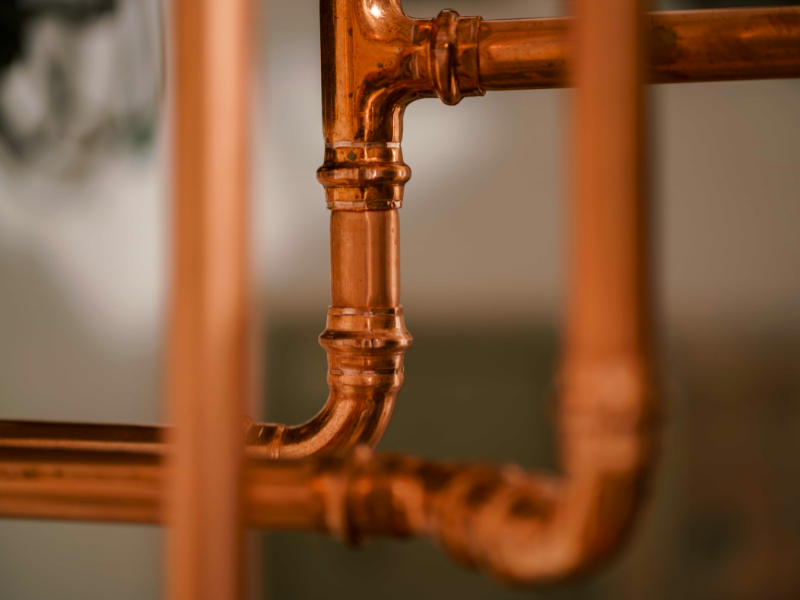
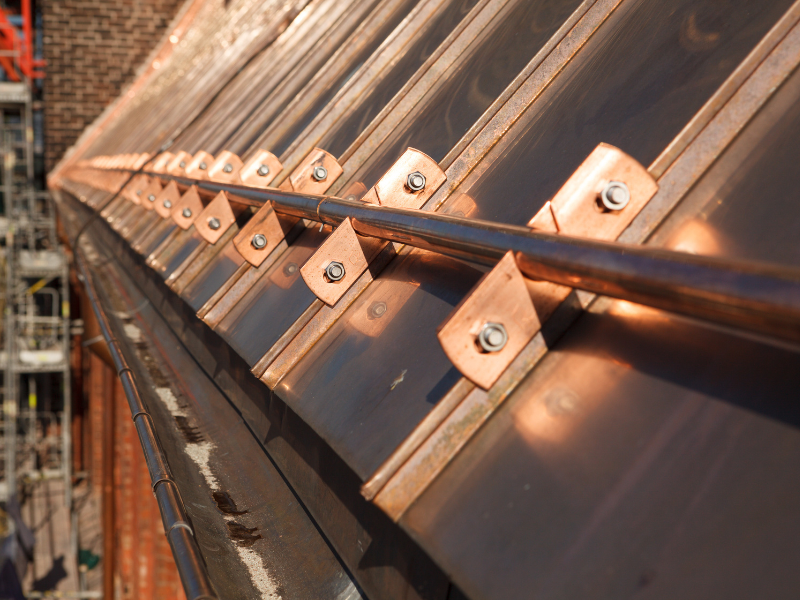
Cladding
A more recent innovation in copper architecture is the red metal’s application in wall cladding. Lightweight and malleable, copper can easily be shaped to make flat, curved or faceted sheets that rest on the facades of buildings.
The variety of colours offered by different copper alloys gives architects plenty of options when it comes to designing the exterior walls of buildings, with some of the most striking examples of copper cladding being Poland’s Museum of Fire and the Museum of Medical History and Innovation in Boston.
Copper is not only selected for its aesthetic qualities, as it also offers the benefits of durability and strong resistance to different weather conditions, including wind, rain and temperature fluctuations.
Guttering
Along with heating and plumbing, copper pipes are also used in drainage systems, helping to collect rainwater that trickles down the roof of a building and diverting it to a drain via a downspout.
It’s vitally important that gutters and downspouts are durable and corrosion-resistant – two qualities that copper has in abundance – as leaks can cause serious structural damage to a building.
Copper is less susceptible to rust than and damage from ice than aluminium, another popular material for guttering systems, and also adds character to the exterior of buildings thanks to its unique appearance.
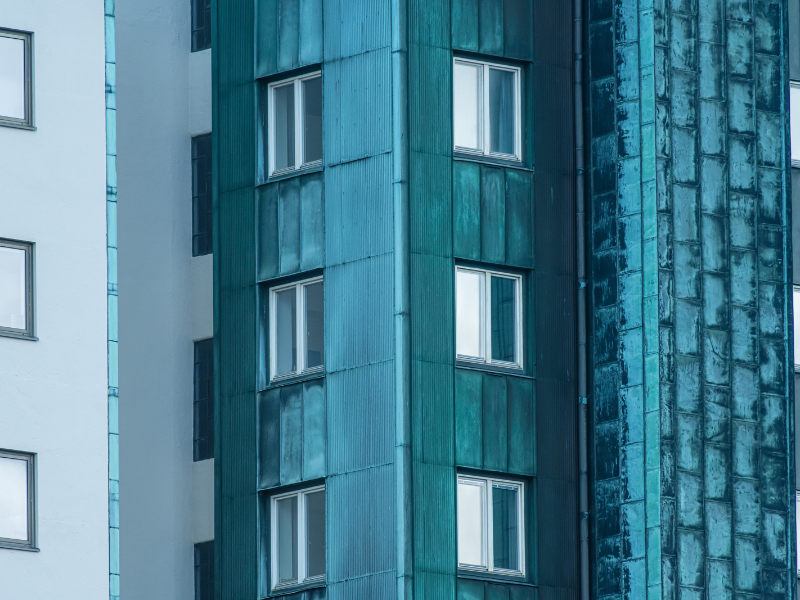
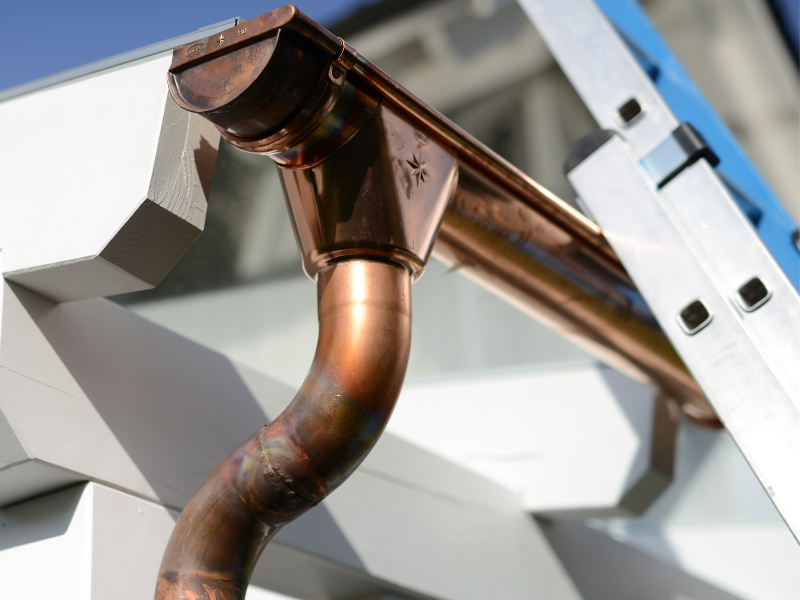
High-touch surfaces
One of the fastest-growing uses of copper in construction is high-touch surfaces like handrails, countertops and bedrails, where the metal’s contact-killing properties help prevent the spread of harmful bacteria and viruses.
In 2008, copper was officially registered as the first naturally antimicrobial solid material by the US Environmental Protection Agency and has since been specified in various buildings and public spaces where the risk of infectious transmission is especially high.
During the COVID-19 pandemic, copper coatings were added to high-touch surfaces on busy public transport networks in Vancouver. In hospitals, a 2019 study found that beds with copper frames harboured an average of 95% fewer bacteria than standard beds.
Decorative elements
From staircases and railings to door handles, interior walls and lighting fixtures, copper is often used by designers to add a touch of elegance and sophistication to decorative elements within the home.
Its range of colours and textures can be manipulated to evoke different styles and complement other ornaments, from the high shine of polished copper to darker shades that form following oxidation.
In the built environment, copper is used to make sculptures and monuments, the most iconic of which being the Statue of Liberty, which sports the distinctive green-blue tint of oxidised copper.
Learn more about copper’s versatile range of uses below
Comparing copper to other building materials
Lightweight, long-lasting and backed up by a proven safety record, there are few materials with such a well-rounded set of properties for use in construction than copper. On top of these functional benefits, the red metal is also incredibly sustainable and aesthetically pleasing.
Copper vs other metals
When comparing copper and its alloys to other metals commonly used in construction, only stainless steel can truly be said to offer better durability. However, the trade-off for this is that stainless steel is heavier and far less malleable than copper, making it less suitable for shaping into intricate designs.
Aluminium is another metal that’s known for being lightweight and affordable. Like copper, it is often used in roofing and cladding systems, but is more prone to corrosion and less durable than the red metal, generally giving it a shorter service life.
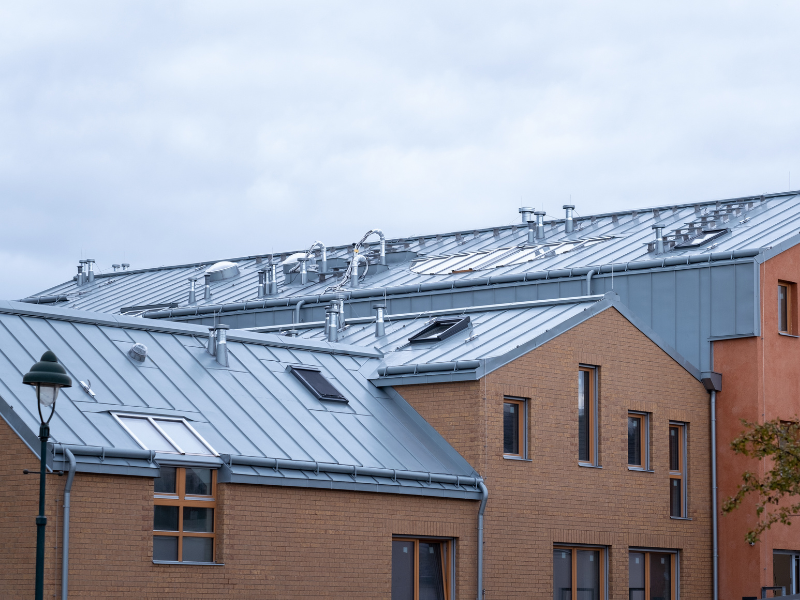
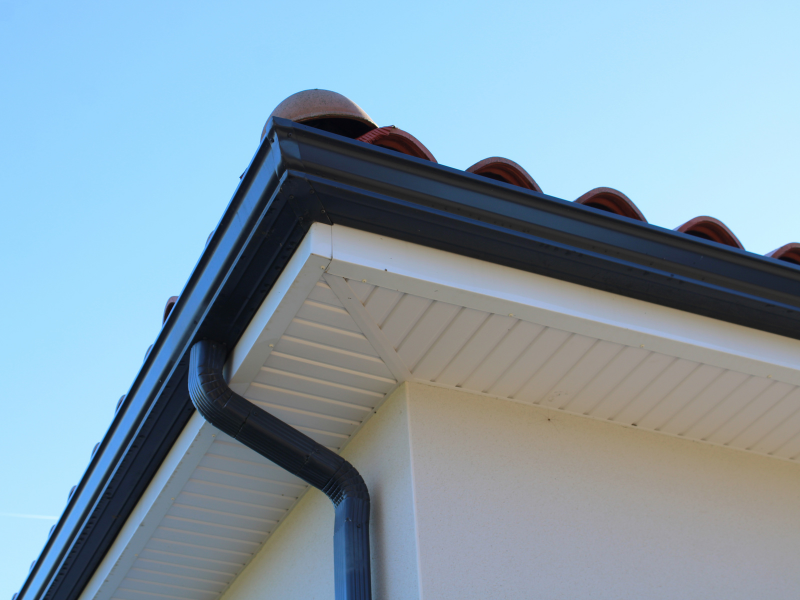
Another edge that copper has over these metals is its antimicrobial resistance, making it a better option for high-touch surfaces and piping systems that need to keep their contents sterile. The aesthetic appeal of copper also makes it the preferred choice in design elements where looks play an important part.
Where other metals excel in a particular area or function, copper is recognised as having a well-rounded set of properties, making it an incredibly versatile material with uses across the construction landscape.
Copper vs plastic
For hundreds of years the built environment has been comprised mainly of stone, concrete and metal, but in recent decades plastic usage has grown considerably, with the likes of PVC, PE and HDPE now some of the most widely used building materials around.
Given that plastics are a relatively new construction material, their true service life remains uncertain, but what is clear is that they are much less durable than metal alternatives like copper, and as such generally require more ongoing maintenance and earlier replacement.
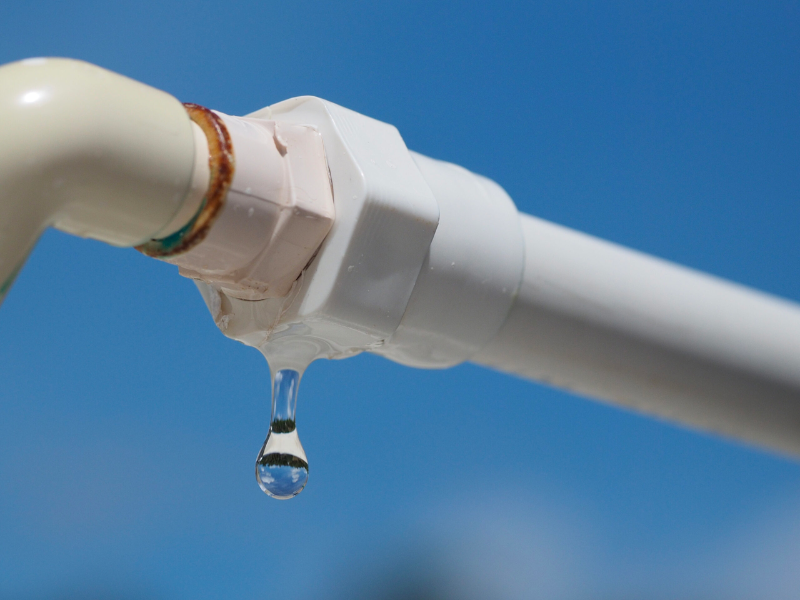
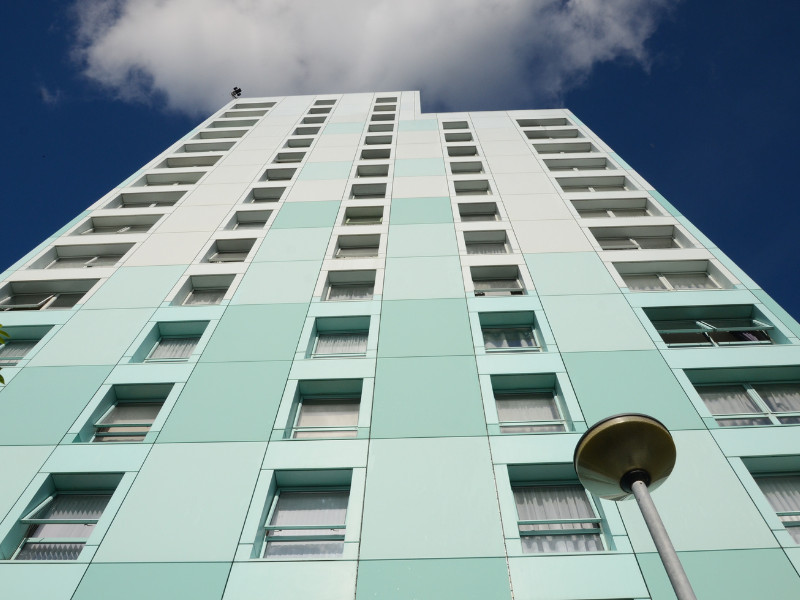
Not only are plastic construction materials structurally weaker than metals, but also introduce unnecessary risks to human health. A mounting body of research is raising concerns about the toxic chemicals found in many plastics, while they also pose considerable risks to fire safety.
Another major issue with plastic materials is their poor sustainability credentials. Despite the claims made by plastic manufacturers, most plastics still aren’t being recycled, and where they are, the process can only be repeated two or three times before the recycled materials become unusable.
Metals like copper, on the other hand, can be recycled infinitely without any loss of quality, supporting a circular economy of reuse and regeneration.
Learn more about the benefits of copper over plastic below
Copper: shaping a sustainable future
There’s a reason why copper has been used in construction projects for thousands of years: the red metal has a unique set of properties that are ideally suited to a wide range of design elements, including pipework, cladding, roofing and guttering.
Not only is copper safe, malleable and long-lasting, but it is also one of the most sustainable construction materials around, as scrap copper can be recycled an infinite number of times to make new products for the circular economy.
With climate action at a crossroads, the construction industry must reduce its reliance on harmful plastic building materials, turning instead to alternatives like copper with a proven record of sustainability and longevity.
Fed up with the plastics greenwash? Want to learn more about the role of copper in shaping a more sustainable future for the construction industry? Check out our news items or subscribe to our newsletter below.